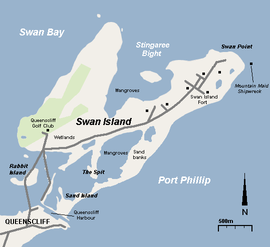Swan Island (Victoria)
|
Swan Island Victoria |
|||||||||||||
|---|---|---|---|---|---|---|---|---|---|---|---|---|---|

Map of Swan Island
|
|||||||||||||
| Postcode(s) | 3225 | ||||||||||||
| Area | 1.40 km2 (0.5 sq mi) | ||||||||||||
| LGA(s) | Borough of Queenscliffe | ||||||||||||
| State electorate(s) | Bellarine | ||||||||||||
| Federal Division(s) | Corangamite | ||||||||||||
|
|||||||||||||
Swan Island is a 1.4 km2 sand barrier island which, with Duck Island and the Edwards Point spit, separate Swan Bay from Port Phillip in Victoria, Australia. It lies close to and north of the town of Queenscliff at the eastern end of the Bellarine Peninsula, and is an official bounded locality of the Borough of Queenscliffe.
Swan Island is home to the Queenscliff Golf Club on land leased from Defence, which occupies the western end of the island, and to the Department of Defence, which operates a training facility occupying the central and eastern parts of the island. It also serves as the land access point for the Queenscliff Cruising Yacht Club on Sand Island. It can be reached by a one-lane vehicular bridge and causeway from Queenscliff via the small saltmarsh-covered Rabbit Island. Access to both Swan and Sand Islands is restricted to members of the golf and yacht clubs, Defence Department personnel, or by permit, with the only road guarded by a security gate. The bay between the western and eastern lobes of the island is Stingaree Bight.
Swan Island now adjoins Sand Island, formed by the cutting of a channel between Port Phillip and Swan Bay to make the entrance to Queenscliff Harbour. The continual maintenance pumping of sand from the harbour's entrance channel to keep it navigable has resulted in longshore drift of sand north-eastwards to connect Sand Island with Swan Island and create two lagoons.
Swan Island's natural vegetation includes areas of coastal scrub, relict patches of coastal woodland and extensive areas of saltmarsh. The island is part of the Swan Bay and Port Phillip Bay Islands Important Bird Area, identified as such by BirdLife International because of its importance for orange-bellied parrots, waders and seabirds. It is ornithologically notable for the critically endangered orange-bellied parrot, for which the saltmarsh serves as one of its few regular wintering sites. Sand Island contains saltmarsh-fringed lagoons bordered in the east by colonising shrubs and grasses on newly formed dunes; its accreting eastern beach, now connected to Swan Island, forms an important high tide roosting area for the migratory waders that feed on the Swan Bay mudflats at low tide, while the lagoons are much used by black swans and other waterbirds.
...
Wikipedia
